Mount Elgon, at the border between Uganda and Kenya, is the oldest and largest solitary volcano in East Africa and features one of the largest intact calderas in the world. Hiking to the top makes for a good adventure. Far less frequented than Kilimanjaro, the National Park around the mountain offers stunning scenery, rare plants and a rich bird population in a quiet atmosphere.
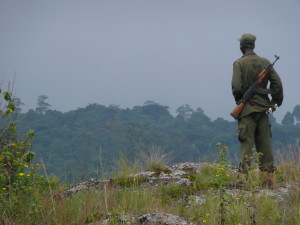
My guide Moses overlooking the forest on Mount Elgon.
“Hi, my name is Moses.” The ranger-guide I had arranged to meet arrived about an hour late. African style. To my surprise, he was also carrying an AK-47. Slightly intimidated, I enquired about the rifle. Moses was tall, slender and had an amiable face and friendly eyes. The weapon was meant to protect us from the creatures of the forest, namely elephants, leopards and pythons. Still thinking a common hunting rifle might have sufficed, we started walking.
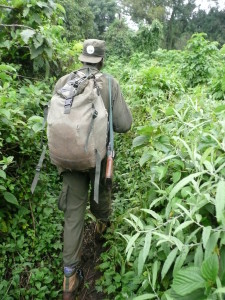
Overgrown trail on the first day.
The trail we were following, more or less, was definitely not heavily frequented. Using a machete, we chopped our way through dense overgrowth. I tried not to walk in the direct line of fire of the AK-47 dangling from my guides shoulder. I had a feeling there are people more adept in the safe handling of a weapon. Adding to my unease was the fact that I had a porter carrying most of my stuff. Being used to carry my fair share, this made me feel uncomfortable. The National Park rules dictate, however, that every visitor employs a guide and a porter. At least that’s what I’ve been told.
Moses stopped sporadically to give me an understanding of the local flora, whilst my feet bogged down into the muddy floor of the rain forest. The area boasts a number of endemic plants and a rich bird population. Luckily, my guide seems to have paid close attention to one of his previous clients, who was an ornithologist.
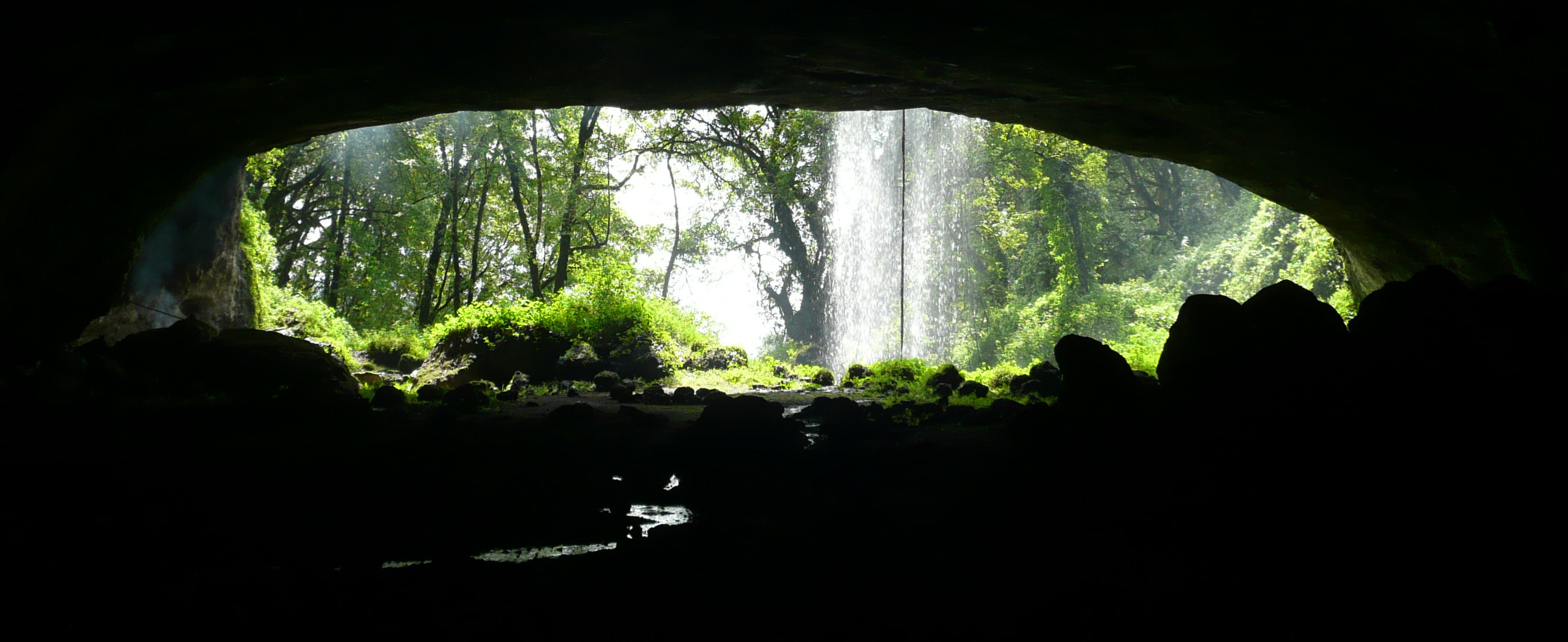
Cave with waterfall curtain. Our camp for the night.
After a couple of strenuous hours of walking uphill we reached our camp for the night: a cave with a waterfall curtain. As it was still quite early, I decided to explore the cave. The farther I walked away from the waterfall, the louder I could hear the squeaking of thousands of bats. The whole ceiling of the cave seemed to be covered in bats. Their eyes reflected the light of my head torch, and some started flying around me. I felt like Batman. No actually I was a bit creeped out.
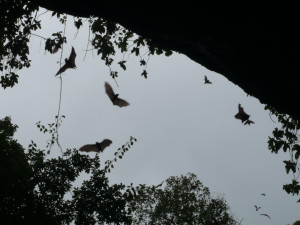
At dusk, hundreds of bats left the cave in search for food.
With thoughts of leopards roaming around, my night-time toilet break developed into a bit of a test of courage. The villagers at the bottom of Mount Elgon apparently lost a number of goats to leopards recently, and the cave is popular with elephants licking the walls for salt. Back in the tent (due to the animals around, the dripping ceiling and the floor being covered in bat excrements, I pitched my tent in the cave) the waterfall on the one side and the squeaking bats on the other side kept me from falling back asleep straight away.
We were off to an early start the next morning. Ready to march just after sunrise. The path was now easier to walk on, the forest became less dense. From around 2,500m height, the mountain is encompassed by a bamboo forest. The scenery changed completely. Apes were crossing our path and every once in a while we came across human footprints. We could hear voices in the distance. The dwellers of the surrounding villages use the bamboo as building material. Small-scale harvesting is legal even within the National Park boundaries to increase acceptance of the park. The extension of the park has reduced cultivation area and hunting grounds.
Stepping out of the bamboo forest finally extended our view past the trees just in front of us. The end of the forest signified the beginning of the boggy, flatter area on the mountain.
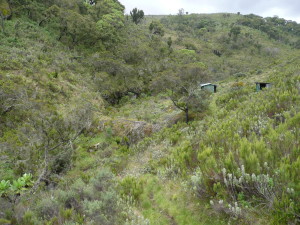
Corrugated iron sheet huts at camp 2.
Unfortunately, the groundsheet of the tent I rented off the National Park was not waterproof. I decided to instead kip with Moses and the porter in a small hut made from corrugated iron sheet. Neither of them were suitably equipped for the cold nights up here, which is why the camp fire was kept alive all night. Inside the hut. My eyes were full of tears and my sleeping bag smelled smoky for months after this.
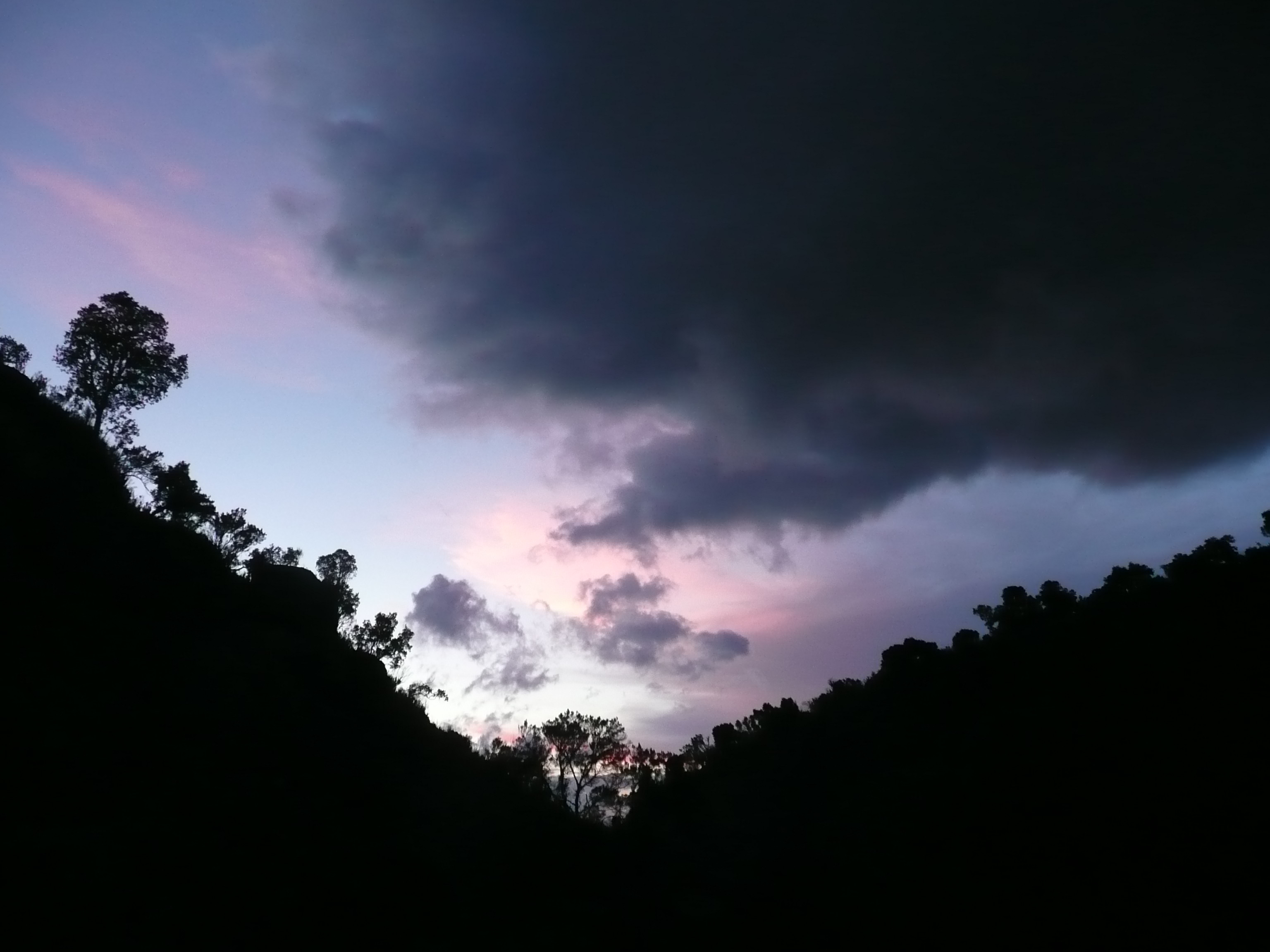
Sunset at camp 2.
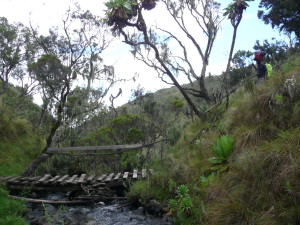
The porter about to cross an old bridge across one of the many streams.
The third day saw us pass the 4,000m mark. The air became thinner, but I was coping well having climbed Kilimanjaro only two weeks before. The morning was still sunny but clouds soon covered the peaks of Mount Elgon from our sight. Our descent to the last camp before summit day took us eastwards across the mountain towards Kenya (although we stayed in Uganda), and back down to 3,500m.
There are plans to develop this side of the mountain for tourism. The camp featured a brand new hut and a surprising number of earth closets.
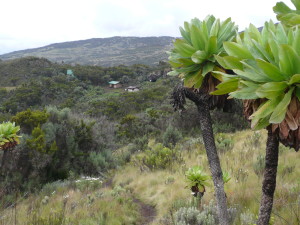
Old and new huts at the last camp before summit day.
For the first time in days we met other people who have ascended from this side of the mountain. Besides me, 4 other tourists with their guides planned to summit the following day. It was nice to engage in conversation again. My guide and the porter weren’t exactly talkative. Just before our dinner was ready it started hailing, but the new hut provided shelter.

On Wagagai summit at 4321m.
After a very cold night, Moses and I started our ascend before any of the others. Our plan was to reach the highest summit (Wagagai) at 4,321m as well as a considerably steeper and hence more exciting subsidiary peak called Jackson Summit (4,165m) before descending all the way down to the Sasa River Camp. Wagagai is a very flat summit and it took a while until we finally stood on the top. Our efforts were rewarded with an amazing view over the caldera and all the other subsidiary peaks. There are numerous lakes in the huge crater. One of the other hikers I met in the last camp was actually here to explore some of them further, camping inside the caldera for a couple of days. The border to Kenya is not far from the summit to the east. Looking southwards I was able to see down the mountain until the steam above the much warmer forest at the bottom concealed the foot of the mountain. I ate my lunch dangling my feet over a small ledge, enjoying the view over the caldera, when it suddenly clouded over and temperatures dropped.
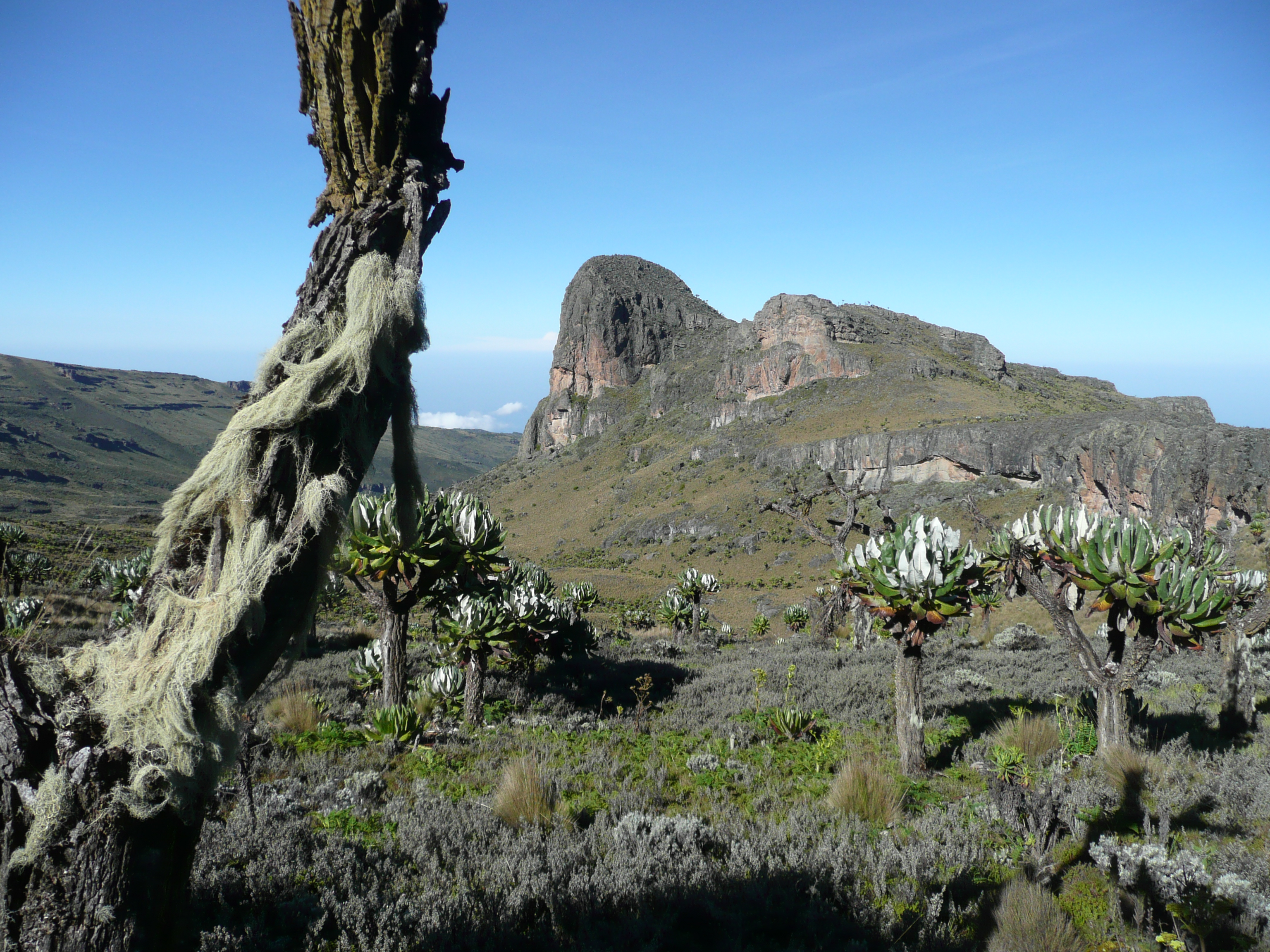
Jackson Summit, one of the many subsidiary peaks on Mount Elgon.
The detour via Jackson Summit required some scrambling but offered nice views back towards the previous summit.
Descending down the mountain temperatures rose quickly, but due to the previous night’s rainfall the track was very muddy.

The first villages at the foot of Mount Elgon.
After a last night on the mountain in another windowless and smoky hut at the Sasa River Camp we reached the first villages at the foot of the mountain in the early afternoon of the following day. Some of the children greeted us amiably, others looked surprised to see us. I had no idea that the most dangerous part of the trip still lay ahead of me. Car taxis are rare and I was left with the options of motorbike or bicycle taxis. Seeing as the trip back to Mbale, where I was planning to take a bus, takes about an hour by motorbike, I opted for that option. Whilst the driver, with my bag on his lap, kept turning around to interrogate me, I tried to pay attention to traffic. We were swerving constantly to avoid potholes and other vehicles. The dusty road made it difficult to keep your eyes open. Neither me nor the driver were wearing a helmet or goggles.
On arrival in Mbale, everybody seemed to already know where I was going. My luggage anyway was already stowed away on a coach to Jinja before the motorbike had come to a complete halt. Somebody helped me off the bike and pushed me onto the bus. For some reason everybody was in a bit of a hurry. Over an hour passed before the bus actually made a move. I was already making plans for the next couple of days in and around Jinja, at the source of the mighty Nile.
Info:
The Uganda Wildlife Authority website has a lot of useful information on Mount Elgon National Park. Book your guide through one of their offices (e.g. in Mbale or Budadiri).
Best time to travel: In the dry seasons from June to August and December to March, but climbing the mountain is possible all year round.
How to get there: Fly to Kampala (8h bus journey to Mbale) or Nairobi (10h by bus to Mbale), local busses or taxis from Mbale can get you to the trail heads.
What route to take: Take the scenic route and ascend via the Sipi trail. Descend via the busier Sasa trail to Budadiri.
Where to stay: Rose’s Last Chance in Budadiri is a popular place to stay with very helpful staff, there are a few places to stay in Mbale. If you want to spend the extra money, you can stay at the Sipi River Lodge on top of a waterfall. The Forest Exploration Centre at the Sipi trail head offers bungalows and has a campsite, too.
Costs: Back in 2010 the park entry including the guide was 50$ per person per day when booked directly through the park authority. A porter cost around 5$ per day.
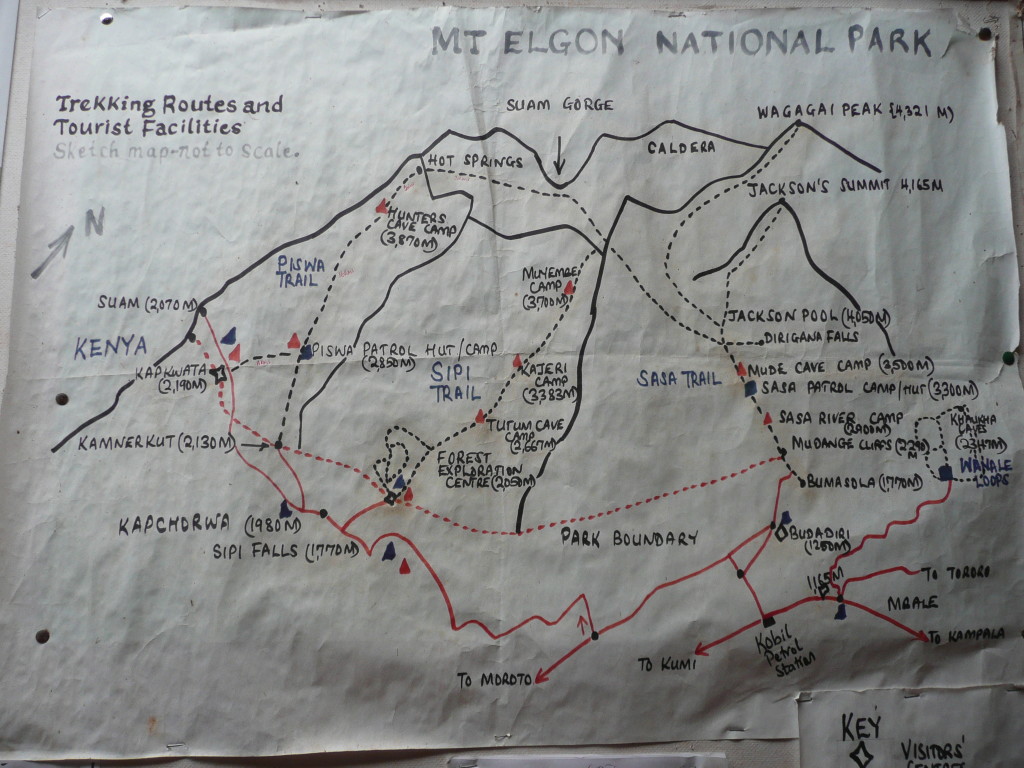
Trail map of Mount Elgon.

Would you add your bat photo as a citizen-science observation to the AfriBats project on iNaturalist?:
http://www.inaturalist.org/projects/afribats
AfriBats will use your observations to better understand bat distributions and help protect bats in Africa.
Please locate your picture on the map as precisely as possible to maximise the scientific value of your records.
Many thanks!
Hi, thanks for your comment. I’ll add the photo along with some others I took in the cave when I get home.